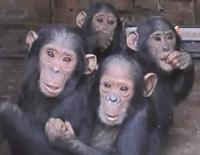Primate News Update: DNA, Extinction and Emergency Plan
This is a sword that cuts both ways. For some, it will reinforce the reasons we should not allow animal testing on chimpanzees; it could be argued that they be accorded the same status as humans who are incapable of giving informed consent to be used in lab tests (i.e., children, adults with mental disabilities, etc.)
On the other hand, unfortunately, there will be those who use this information to justify the use of chimpanzees in laboratory experiments and push to increase captive breeding for that purpose.
Meanwhile, speaking of good news/bad news, how's this for ironic? From Reuters, Sumatran Orangutans Face Extinction:
Rebuilding after December's devastating tsunami and the dawn of peace in Indonesia's Aceh province could mean annihilation for the region's orangutans....Ian Singleton, scientific director of the Sumatran Orangutan Conservation Programme, said of the return to normality after a separatist conflict, "As peace breaks out, so the orangutans could be wiped out."
Orangutan mother and baby
Who would have ever thought that there could be a downside to peace?
But it's not just the Sumatran orangutan whose future in the wild is looking bleak. The United Nation Environmental Program-World Conservation Monitoring Centre has just published The World Atlas of Great Apes and Their Conservation, and the writing is, as they say, on the wall.
There is an editorial in The Herald about this story.
There may yet be hope for some of the great apes, if an emergency plan released this week by conservationists succeeds (reported by Reuters):
Drawn up by more than 70 experts and government officials, the plan designates 12 sites in five countries: Cameroon, Gabon, Congo, Central African Republic, and Equatorial Guinea....Young bonobo
The plan, with a price tag of $30 million over 5 years, has targeted these sites for emergency programs intended to increase security against illegal hunting and logging and slow the spread of the Ebola virus.
Proposed measures include combating poaching and improving monitoring, response to Ebola outbreaks, training and tourism development.
"The plan represents an urgent appeal to the international community for immediate action, before the damage is irreversible," Conservation International said in a statement.

Silverback gorilla and family
Thanks to Sharon Bakar for alerting me to some of these stories and to UNEP-WCMC for the use of the photographs.











0 Comments:
Post a Comment
<< Home